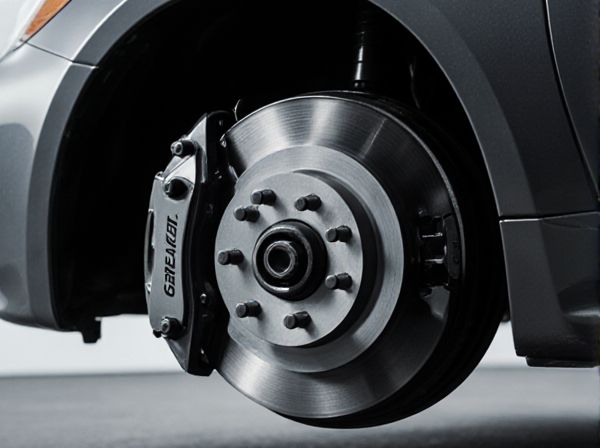
Photo illustration: Hydraulic Braking vs Electromagnetic Braking
Hydraulic braking systems rely on fluid pressure to apply force to brake pads, providing powerful and consistent stopping power ideal for heavy vehicles. Electromagnetic braking uses magnetic fields to create resistance without physical contact, resulting in less wear and faster response times. You can choose hydraulic brakes for reliability in high-pressure situations or electromagnetic brakes for smoother, low-maintenance performance.
Table of Comparison
| Feature | Hydraulic Braking | Electromagnetic Braking |
|---|---|---|
| Operating Principle | Uses fluid pressure to apply brake force | Uses electromagnetic force to generate braking torque |
| Response Time | Moderate, depends on fluid dynamics | Fast, near-instantaneous activation |
| Maintenance | Requires regular fluid checks and replacement | Low maintenance; no fluid needed |
| Wear and Tear | Brake pads and fluid wear over time | Minimal mechanical wear, mainly electrical components |
| Heat Dissipation | Can generate and dissipate significant heat | Lower heat generation due to non-contact braking |
| Energy Efficiency | Standard; energy lost as heat | Regenerative potential; can recover energy |
| Cost | Generally lower initial cost | Higher upfront cost due to complex electronics |
| Application | Widely used in passenger cars and commercial vehicles | Common in electric and hybrid vehicles |
Introduction to Braking Systems
Hydraulic braking systems use fluid pressure to transfer force from the brake pedal to the brake pads, providing strong and reliable stopping power in vehicles. Electromagnetic braking systems employ magnetic fields to create resistance and slow down moving parts without direct contact, often seen in trains and industrial machines. Both systems are essential for safety but differ significantly in mechanism, maintenance, and application.
Overview of Hydraulic Braking
Hydraulic braking systems use fluid pressure to transfer force from the brake pedal to the brake pads, providing efficient and consistent stopping power in vehicles. These systems rely on brake fluid contained in a master cylinder, which distributes pressure through brake lines to hydraulic calipers or wheel cylinders. Known for their reliability and strong braking force, hydraulic brakes are commonly used in automobiles and heavy machinery for superior control and safety.
Overview of Electromagnetic Braking
Electromagnetic braking utilizes magnetic fields to create resistance and slow down a vehicle or machinery without direct contact, reducing wear and maintenance compared to hydraulic systems. This braking method is highly efficient for applications requiring precise control and rapid response, often found in trains, elevators, and industrial equipment. Electromagnetic brakes generate heat through eddy currents, allowing smooth deceleration and enhanced durability in high-performance environments.
Working Principles: Hydraulic vs Electromagnetic
Hydraulic braking operates by using brake fluid to transmit pressure from the brake pedal to the brake pads, creating friction that slows the vehicle. Electromagnetic braking employs magnetic fields generated by electric currents to induce eddy currents in a metal disc, producing resistance that decelerates motion without physical contact. Both systems convert kinetic energy into heat, but hydraulic brakes rely on fluid dynamics, whereas electromagnetic brakes use electromagnetic induction for stopping power.
Performance Comparison
Hydraulic braking systems offer high stopping power with consistent force distribution and excellent heat dissipation, making them ideal for heavy-duty and high-speed applications. Electromagnetic braking provides rapid response and low maintenance due to the absence of friction components, but it may deliver lower braking torque compared to hydraulic systems. Performance efficiency in hydraulic brakes excels under sustained heavy loads, while electromagnetic brakes shine in precision control and energy recovery scenarios.
Efficiency and Response Time
Hydraulic braking systems offer high efficiency through strong, consistent friction forces, enabling rapid stopping power with minimal lag in response time. Electromagnetic braking provides faster response times due to the absence of mechanical wear and direct activation via electrical signals, although efficiency can vary with temperature and material properties. Comparing both, hydraulic brakes excel in sustained heavy-duty applications, while electromagnetic brakes optimize quick modulation and reduced maintenance.
Maintenance and Durability
Hydraulic braking systems require regular maintenance including fluid checks and brake pad replacements due to fluid leaks and wear-prone components, which can affect long-term durability. Electromagnetic braking systems offer enhanced durability with minimal wear since they rely on magnetic forces rather than friction, reducing maintenance frequency. However, electromagnetic brakes may need periodic inspection of electrical components to ensure consistent performance and longevity.
Safety Features and Reliability
Hydraulic braking systems deliver consistent stopping power with built-in pressure modulation and fail-safe mechanisms that ensure reliability under extreme conditions. Electromagnetic braking offers precise control and reduced mechanical wear due to non-contact operation, enhancing safety by minimizing brake fade and maintenance-related failures. Both systems prioritize safety, but hydraulic brakes excel in durability and widespread application, while electromagnetic brakes provide faster response times and smoother deceleration.
Applications in Modern Vehicles
Hydraulic braking systems dominate conventional vehicles due to their reliability in providing consistent stopping power through fluid pressure. Electromagnetic braking is increasingly utilized in electric and hybrid vehicles, leveraging regenerative braking to improve energy efficiency and reduce wear. Advances in brake-by-wire technology integrate both systems, enhancing vehicle safety and performance in modern automotive applications.
Future Trends in Braking Technology
Future trends in braking technology emphasize the integration of electromagnetic braking systems with advanced hydraulic components to enhance energy efficiency and reduce wear. Regenerative braking combined with electromagnetic mechanisms is increasingly adopted in electric and hybrid vehicles, offering superior heat dissipation and precise control. Innovations in smart braking systems leverage sensors and AI to optimize braking response, promising safer and more sustainable transportation solutions.
 caratoz.com
caratoz.com